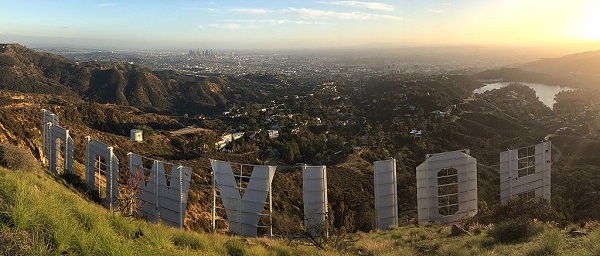Uncategorized
Scientists reveal first image ever made of a black hole

WASHINGTON — Scientists on Wednesday revealed the first image ever made of a black hole, depicting its hot, shadowy edges where light bends around itself in a cosmic funhouse effect.
Assembling data gathered by eight radio telescopes around the world, astronomers created the picture showing the violent neighbourhood around a supermassive black hole, the light-sucking monsters of the universe theorized by Einstein more than a century ago and confirmed by observations for decades.
It looked like a flaming orange, yellow and black ring.
“We have seen what we thought was unseeable. We have seen and taken a picture of a black hole. Here it is,” said Sheperd Doeleman of Harvard.
Jessica Dempsey, a co-discoverer and deputy director of the East Asian Observatory in Hawaii, said it reminded her of the powerful flaming Eye of Sauron from the “Lord of the Rings” trilogy.
Unlike smaller black holes that come from collapsed stars, supermassive black holes are mysterious in origin. Situated at the centre of most galaxies, including ours, they are so dense that nothing, not even light, can escape their gravitational pull. This one’s “event horizon” — the point of no return around it, where light and matter begin to fall inexorably into the abyss — is as big as our entire solar system.
Three years ago, scientists using an extraordinarily sensitive observing system heard the sound of two much smaller black holes merging to create a gravitational wave, as Albert Einstein predicted. The new image, published in the Astrophysical Journal Letters and announced around the world in several news conferences, adds light to that sound.
Outside scientists suggested the achievement could be worthy of a Nobel Prize, just like the gravitational wave discovery.
While much around a black hole falls into a death spiral and is never to be seen again, the new image captures “lucky gas and dust” circling at just far enough to be safe and seen millions of years later on Earth, Dempsey said.
Taken over four days when astronomers had “to have the perfect weather all across the world and literally all the stars had to align,” the image helps confirm Einstein’s general relativity theory, Dempsey said. Einstein a century ago even predicted the symmetrical shape that scientists just found, she said.
“It’s circular, but on one side the light is brighter,” Dempsey said. That’s because that light is approaching Earth.
The measurements are taken at a wavelength the human eye cannot see, so the astronomers added colour to the image. They chose “exquisite gold because this light is so hot,” Dempsey said. “Making it these warm gold and oranges makes sense.”
What the image shows is gas heated to millions of degrees by the friction of ever-stronger gravity, scientists said. And that gravity creates a funhouse effect where you see light from both behind the black hole and behind you as the light curves and circles around the black hole itself, said astronomer Avi Loeb, director of the Black Hole Initiative at Harvard. (The lead scientists in the discovery are from Harvard, but Loeb was not involved.)
The project cost $50 million to $60 million, with $26 million of that coming from the National Science Foundation.
Johns Hopkins astrophysicist Ethan Vishniac, who was not part of the discovery team but edits the journal where the research was published, pronounced the image “an amazing technical achievement” that “gives us a glimpse of gravity in its most extreme manifestation.”
He added: “Pictures from computer simulations can be very pretty, but there’s literally nothing like a picture of the real universe, however fuzzy and monochromatic.”
“It’s just seriously cool,” said John Kormendy, a University of Texas astronomer who wasn’t part of the discovery team. “To see the stuff going down the tubes, so to speak, to see it firsthand. The mystique of black holes in the community is very substantial. That mystique is going to be made more real.”
There is a myth that says a black hole would rip you apart, but Loeb and Kormendy said the one pictured is so big, someone could fall into it and not be torn to pieces. But the person would never be seen from again.
Black holes are “like the walls of a prison. Once you cross it, you will never be able to get out and you will never be able to communicate,” Loeb said.
The first image is of a black hole in a galaxy called M87 that is about 53 million light years from Earth. One light year is 5.9 trillion miles, or 9.5 trillion kilometres. This black hole is about 6 billion times the mass of our sun.
The telescope data was gathered by the Event Horizon Telescope two years ago, but it took so long to complete the image because it was a massive undertaking, involving about 200 scientists, supercomputers and hundreds of terabytes of data delivered worldwide by plane.
The team looked at two supermassive black holes, the M87 and the one at the centre of our own Milky Way galaxy. The one in our galaxy is closer but much smaller, so they both look the same size in the sky. But the more distant one was easier to take pictures of because it rotates more slowly.
“We’ve been hunting this for a long time,” Dempsey said. “We’ve been getting closer and closer with better technology.”
___
The Associated Press Health and Science Department receives support from the Howard Hughes Medical Institute’s Department of Science Education. The AP is solely responsible for all content.
Seth Borenstein, The Associated Press
Uncategorized
Cost of bureaucracy balloons 80 per cent in 10 years: Public Accounts

The cost of the bureaucracy increased by $6 billion last year, according to newly released numbers in Public Accounts disclosures. The Canadian Taxpayers Federation is calling on Prime Minister Mark Carney to immediately shrink the bureaucracy.
“The Public Accounts show the cost of the federal bureaucracy is out of control,” said Franco Terrazzano, CTF Federal Director. “Tinkering around the edges won’t cut it, Carney needs to take urgent action to shrink the bloated federal bureaucracy.”
The federal bureaucracy cost taxpayers $71.4 billion in 2024-25, according to the Public Accounts. The cost of the federal bureaucracy increased by $6 billion, or more than nine per cent, over the last year.
The federal bureaucracy cost taxpayers $39.6 billion in 2015-16, according to the Public Accounts. That means the cost of the federal bureaucracy increased 80 per cent over the last 10 years. The government added 99,000 extra bureaucrats between 2015-16 and 2024-25.
Half of Canadians say federal services have gotten worse since 2016, despite the massive increase in the federal bureaucracy, according to a Leger poll.
Not only has the size of the bureaucracy increased, the cost of consultants, contractors and outsourcing has increased as well. The government spent $23.1 billion on “professional and special services” last year, according to the Public Accounts. That’s an 11 per cent increase over the previous year. The government’s spending on professional and special services more than doubled since 2015-16.
“Taxpayers should not be paying way more for in-house government bureaucrats and way more for outside help,” Terrazzano said. “Mere promises to find minor savings in the federal bureaucracy won’t fix Canada’s finances.
“Taxpayers need Carney to take urgent action and significantly cut the number of bureaucrats now.”
Table: Cost of bureaucracy and professional and special services, Public Accounts
| Year | Bureaucracy | Professional and special services |
|
$71,369,677,000 |
$23,145,218,000 |
|
|
$65,326,643,000 |
$20,771,477,000 |
|
|
$56,467,851,000 |
$18,591,373,000 |
|
|
$60,676,243,000 |
$17,511,078,000 |
|
|
$52,984,272,000 |
$14,720,455,000 |
|
|
$46,349,166,000 |
$13,334,341,000 |
|
|
$46,131,628,000 |
$12,940,395,000 |
|
|
$45,262,821,000 |
$12,950,619,000 |
|
|
$38,909,594,000 |
$11,910,257,000 |
|
|
$39,616,656,000 |
$11,082,974,000 |
Uncategorized
Trump Admin Establishing Council To Make Buildings Beautiful Again


From the Daily Caller News Foundation
By Jason Hopkins
The Trump administration is creating a first-of-its-kind task force aimed at ushering in a new “Golden Age” of beautiful infrastructure across the U.S.
The Department of Transportation (DOT) will announce the establishment of the Beautifying Transportation Infrastructure Council (BTIC) on Thursday, the Daily Caller News Foundation exclusively learned. The BTIC seeks to advise Transportation Secretary Sean Duffy on design and policy ideas for key infrastructure projects, including highways, bridges and transit hubs.
“What happened to our country’s proud tradition of building great, big, beautiful things?” Duffy said in a statement shared with the DCNF. “It’s time the design for America’s latest infrastructure projects reflects our nation’s strength, pride, and promise.”
“We’re engaging the best and brightest minds in architectural design and engineering to make beautiful structures that move you and bring about a new Golden Age of Transportation,” Duffy continued.
Mini scoop – here is the DOT’s rollout of its Beautifying Transportation Infrastructure Council, which will be tasked with making our buildings beautiful again. pic.twitter.com/
9iV2xSxdJM — Jason Hopkins (@jasonhopkinsdc) October 23, 2025
The DOT is encouraging nominations of the country’s best architects, urban planners, artists and others to serve on the council, according to the department. While ensuring that efficiency and safety remain a top priority, the BTIC will provide guidance on projects that “enhance” public areas and develop aesthetic performance metrics.
The new council aligns with an executive order signed by President Donald Trump in August 2025 regarding infrastructure. The “Making Federal Architecture Beautiful Again” order calls for federal public buildings in the country to “respect regional architectural heritage” and aims to prevent federal construction projects from using modernist and brutalist architecture styles, instead returning to a classical style.
“The Founders, in line with great societies before them, attached great importance to Federal civic architecture,” Trump’s order stated. “They wanted America’s public buildings to inspire the American people and encourage civic virtue.”
“President George Washington and Secretary of State Thomas Jefferson consciously modeled the most important buildings in Washington, D.C., on the classical architecture of ancient Athens and Rome,” the order continued. “Because of their proven ability to meet these requirements, classical and traditional architecture are preferred modes of architectural design.”
The DOT invested millions in major infrastructure projects since Trump’s return to the White House. Duffy announced in August a $43 million transformation initiative of the New York Penn Station in New York City and in September unveiledmajor progress in the rehabilitation and modernization of Washington Union Station in Washington, D.C.
The BTIC will comprise up to 11 members who will serve two-year terms, with the chance to be reappointed, according to the DOT. The task force will meet biannually. The deadline for nominations will end Nov. 21.
-

 Alberta2 days ago
Alberta2 days agoAlberta on right path to better health care
-

 Crime2 days ago
Crime2 days ago‘Modern-Day Escobar’: U.S. Says Former Canadian Olympian Ran Cocaine Pipeline with Cartel Protection and a Corrupt Toronto Lawyer
-

 Business1 day ago
Business1 day agoCanada is failing dismally at our climate goals. We’re also ruining our economy.
-

 Alberta2 days ago
Alberta2 days agoAlberta Emergency Alert test – Wednesday at 1:55 PM
-

 Health21 hours ago
Health21 hours agoCDC’s Autism Reversal: Inside the Collapse of a 25‑Year Public Health Narrative
-

 Alberta2 days ago
Alberta2 days agoCarney government’s anti-oil sentiment no longer in doubt
-

 Artificial Intelligence2 days ago
Artificial Intelligence2 days agoLawsuit Claims Google Secretly Used Gemini AI to Scan Private Gmail and Chat Data
-

 Alberta1 day ago
Alberta1 day agoAlberta to protect three pro-family laws by invoking notwithstanding clause










